
Light bulb by ColiNOOB (Pixabay License / Pixabay)
The Fantastic Four characters, created by Stan Lee and Jack Kirby, first appeared in The Fantastic Four #1 (November 1961). Thus began an explosion of brilliant, enduring pop culture characters from the creators at Marvel Comics in the early to mid-’60s. This explosion yielded Spider-Man, Thor, Hulk, Iron Man, the X-Men, the Avengers, Daredevil, Doctor Strange and many more. It all started with the Fantastic Four, and they were Marvel’s flagship characters throughout the ’60s, as Lee and Kirby produced their legendary 102-issue run on the book.
But after their partnership dissolved,
Fantastic Four stagnated as succeeding writers opted to revisit old concepts rather than push the boundaries of action/sci-fi comics. The comic books also suffered as tastes in comics changed and the bright, optimistic, goofy tone of Fantastic Four fell out of favour with readers. There were bright moments in the series under such writers as John Byrne, Mark Waid and Jonathan Hickman, but the comics and their historical significance became overshadowed by Marvel’s other output.
Things did not improve for the property as comic book films became the dominant form of blockbusters in the ’00s. 20th Century Fox produced two films,
Fantastic Four (Story, 2005) and Fantastic Four: Rise of the Silver Surfer (Story, 2007), that were poor adaptations narratively and tonally, and failed to break out commercially. The characters could not be foundational to the Marvel Cinematic Universe (MCU), launched by Marvel Studios in 2008, as they were to the Marvel Comics universe, because Fox owned the film rights to the property. So, as the MCU became an inescapable cultural juggernaut, powered mostly by characters that came out of Marvel’s creative explosion of the ’60s, the property that started it all remained sidelined.
Fox had fumbled the Fantastic Four property twice, but the studio still hoped to make it work. In 2009, Fox hired a producer and writer to reboot the Fantastic Four, but nothing came of it. In 2011, Fox hired Zack Stentz and Ashley Edward Miller, screenwriters of
X-Men: First Class (Vaughn, 2011), to write a large-scale team-up film featuring every Marvel property owned by the studio at the time (the X-Men, Deadpool, Daredevil, and the Fantastic Four). This film was intended to compete with the upcoming MCU team-up film, The Avengers (Whedon, 2012). When the Fox team-up project was cancelled, Stentz and Miller wrote a new screenplay focused entirely on the Fantastic Four. This screenplay was thrown out by Josh Trank when he was hired in 2012 to direct the new Fantastic Four film and insisted on writing his own screenplay from scratch. And so, after a lot of false starts, things finally started moving under Trank. But what direction would he take his film?
Ultimate Comics began in 2000 as a way to reimagine classic Marvel characters and storylines with modern sensibilities. The core idea was that new readers could use Ultimate Comics catch up on key characters, without the decades of daunting backstory and continuity. The line began with Ultimate Spider-Man, followed soon after by Ultimate X-Men and The Ultimates (a version of the Avengers), then Ultimate Fantastic Four starting in 2004. The modern, grounded aesthetics of the Ultimate line made its way into Marvel Films almost immediately.
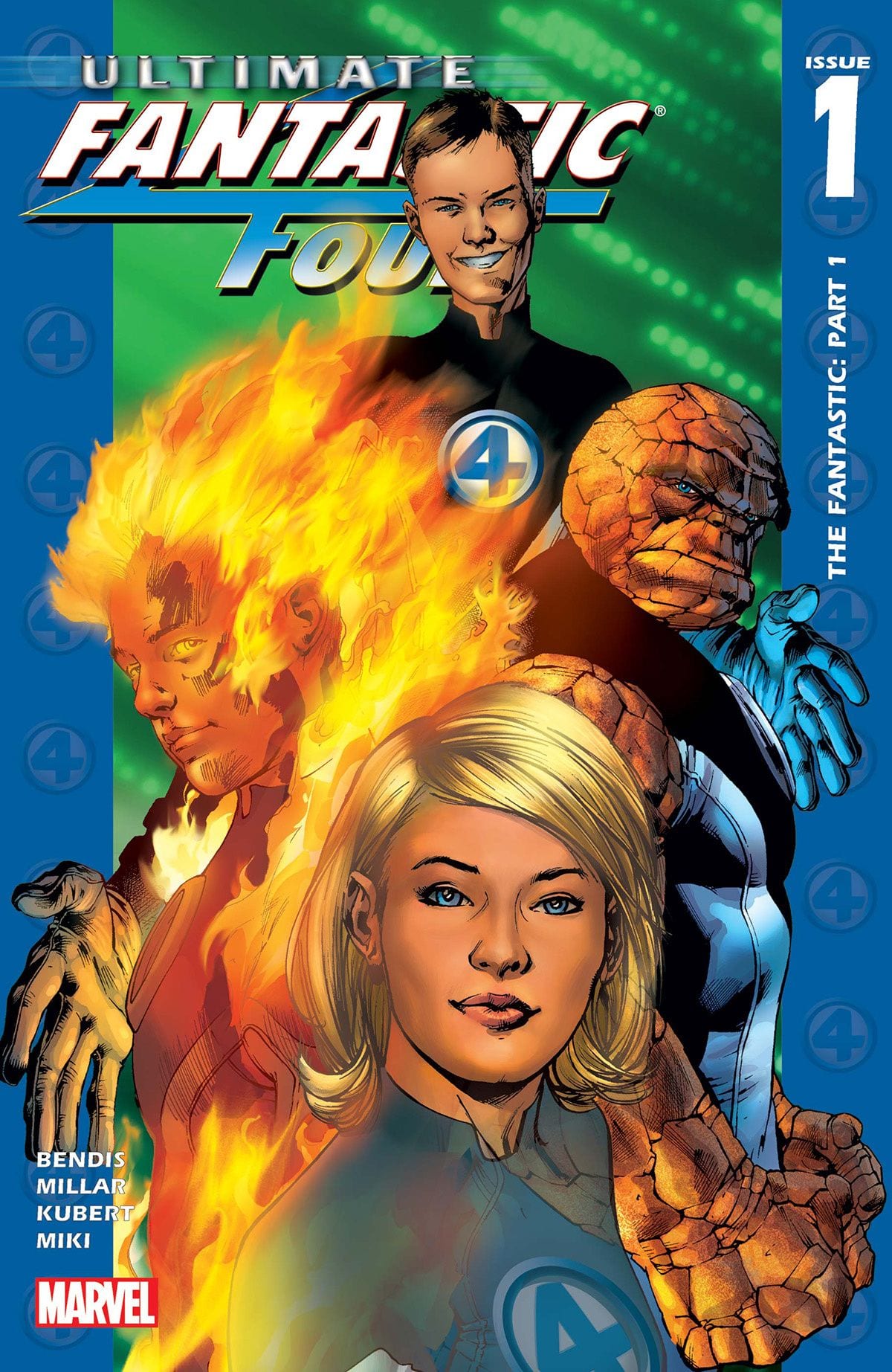
By 2012, The Avengers (heavily inspired by The Ultimates) and The Amazing Spider-Man (Webb, 2012) (heavily inspired by Ultimate Spider-Man) were both released, bringing the grounded narrative approach of Ultimate Comics to film. In the case of The Amazing Spider-Man, the filmmakers adapted Ultimate Comics rather than the classic Spider-Man Comics to distinguish the reboot from the earlier, highly-successful trilogy of Spider-Man films. This seemed to offer a roadmap to achieving the same thing with the Fantastic Four.
The classic Fantastic Four comics feature the characters Reed Richards, a brilliant scientist in his late-30s, Ben Grimm, Reed’s best friend and pilot, Sue Storm, Reed’s fiancée, and Johnny Storm, Sue’s teenage brother. The group steals a rocket of Reed’s design to beat the Soviet Union into space and are bombarded by cosmic rays that give them amazing powers. Reed can stretch, Ben is a super-strong rock monster, Sue can turn invisible, and Johnny can catch on fire and fly. They use their powers to explore time, space and other dimensions, battling monsters and villains, such as the despotic Dr. Doom, while bickering like a family.
In Ultimate Fantastic Four, Reed is reimagined as a teenage genius recruited to a think tank by Franklin Storm. Other students at the think tank include Storm’s children, Sue and Johnny, and Victor van Damme. Jealous of Reed, Victor sabotages his teleportation device before a test. Reed, Victor, Sue, Johnny and Ben, Reed’s childhood friend visiting for the test, are all caught in the accident and given their powers. Reed is the character most drastically changed in this version. The reduced age of the character, and Sue’s equal intellect, diminishes his authority in the team. The concept and science behind the book is also heavily modernized from the Space Age, ’60s-set original comics.
Adapting this more modern, grounded version of the Fantastic Four to film seemed clever but, in retrospect, it was misguided. The Amazing Spider-Man was adapted from Ultimate Comics by necessity, to distinguish it from some of the most successful blockbusters of the previous decade. The previous Fantastic Four films were not particularly successful or well-received, so it may have made more sense to craft a film more faithful to the original, highly-popular comics rather than adapt a drastic reimagining.
The Amazing Spider-Man and The Amazing Spider-Man 2 (Webb, 2014) were also commercial disappointments, spoiling grand plans for a Spider-Man Cinematic Universe. That is not the best model to follow. Also those films adapted Ultimate Spider-Man, a critically-acclaimed, popular comic that ran for 200 issues. Ultimate Fantastic Four never gained comparable popularity or acclaim, and ended after 60 issues. Finally, the entire Ultimate Comics line, declining in popularity since its peak in the mid-’00s, was on its last legs by the time the new Fantastic Four film was in production. So, this new film was anchoring itself to a sinking ship.
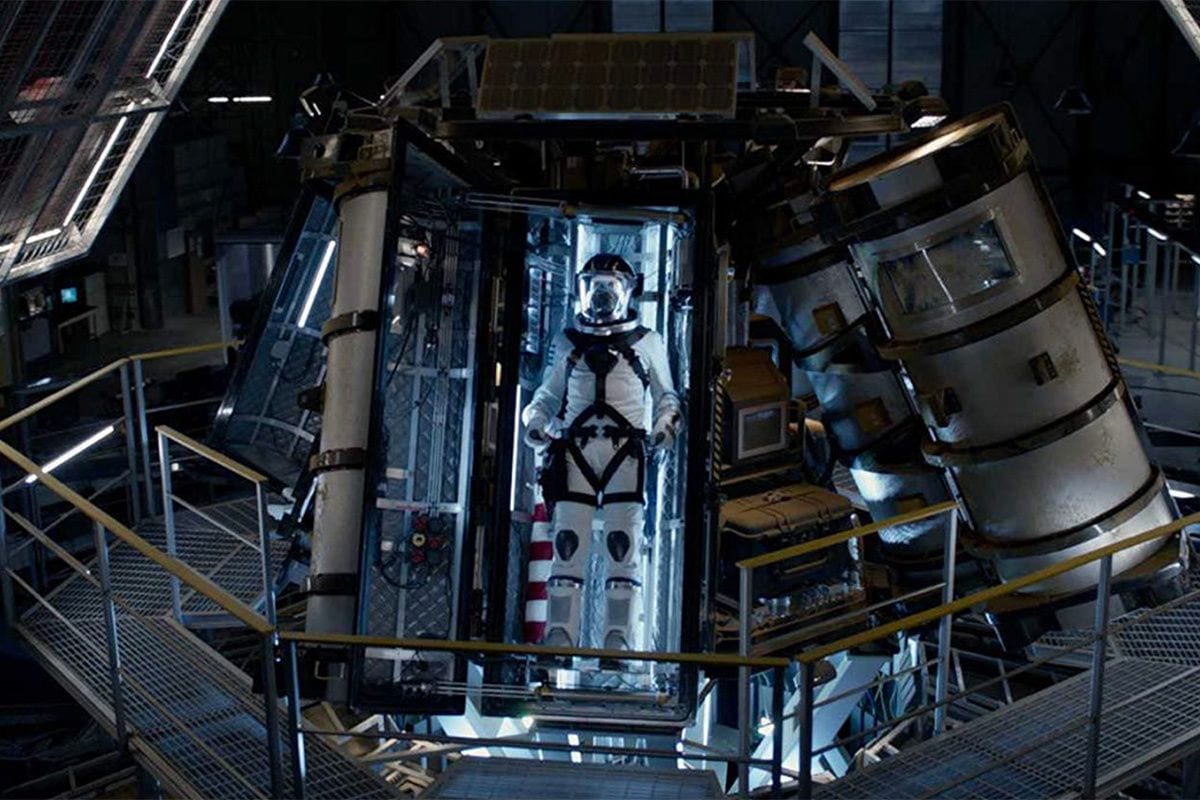
(IMDB)
Problems with Fantastic Four did not end there. Trank completed his script and casting by early 2014. Filming began soon after, and was completed in August, one year before the release date. In January 2015, however, there were reports that Fox had ordered extensive rewrites and reshoots of the film without Trank’s input. Rumours began to swirl regarding conflicts between Trank and Fox studio executives over the film. Trank became characterized as behaving erratically on set, and acting combative towards the cast and crew. Lucasfilm had previously hired Trank to direct a Star Wars spinoff film following Fantastic Four, rumoured to be based around Boba Fett, but they cancelled the film following an investigation into Trank’s behaviour.
On the other hand, Fox executives were rumoured to have interfered with the film to the point of sabotage, slashing the budget nearly 25% just before filming began, demanding script changes at the last minute, and delaying major decisions. Fox has a poor history of meddling with its films. I have written about other disastrous examples, such as Daredevil (Johnson, 2003) and X-Men Origins: Wolverine (Hood, 2009), that match these stories. Ultimately, The Fantastic Four was completed without Trank’s involvement. On the eve of the film’s release, in response to overwhelming negative buzz, Trank tweeted (and soon deleted), “A year ago I had a fantastic version of this. And it would’ve recieved [sic] great reviews. You’ll probably never see it. That’s reality though.” This was likely an attempt to distance himself from a failure, but it established the public perception of the film: Fantastic Four was a disaster, a total mess, even the director disowns it.
Looking at the film now, separate from all of the gossip and bad press, it’s difficult to parse which elements are a part of Trank’s original vision and which are a result of post-Trank remodelling. I will say that the first half of the film is a decent adaptation of Ultimate Fantastic Four. It’s grounded, muted, and has the excitement of invention. The character development leaves a lot to be desired, and the “Ultimate” approach likely turned off some die-hard classic Fantastic Four fans, but it has potential.
The second half of the film, however, is an absolute disaster. Not even an interesting, exciting, train-wreck disaster, but a disaster of boredom. It’s as if in the second half all the interesting, exciting bits were cut. All that’s left are long stretches of underdeveloped characters talking about their motivations, their intentions, their feelings. For a long time there’s no action. It’s all telling, no showing. The one bit of genuine action is the climax, which is perfunctory and disconnected from the rest of the film. And then it’s over, with all of the potential of the first half, and possibly of the Fantastic Four as a cinematic property, squandered.
Fantastic Four opens with ten-year-old Reed Richards (Owen Judge) presenting his idea for a teleporter to his class, only to be misunderstood and shut down by his science teacher. Later, Reed is caught by his classmate, Ben (Evan Hannemann), stealing from the junkyard owned by Ben’s family to make the teleporter in his garage. Ben helps him test the device, which sends a toy car somewhere while returning orange dirt. The test also causes a widespread power outage in the neighbourhood.
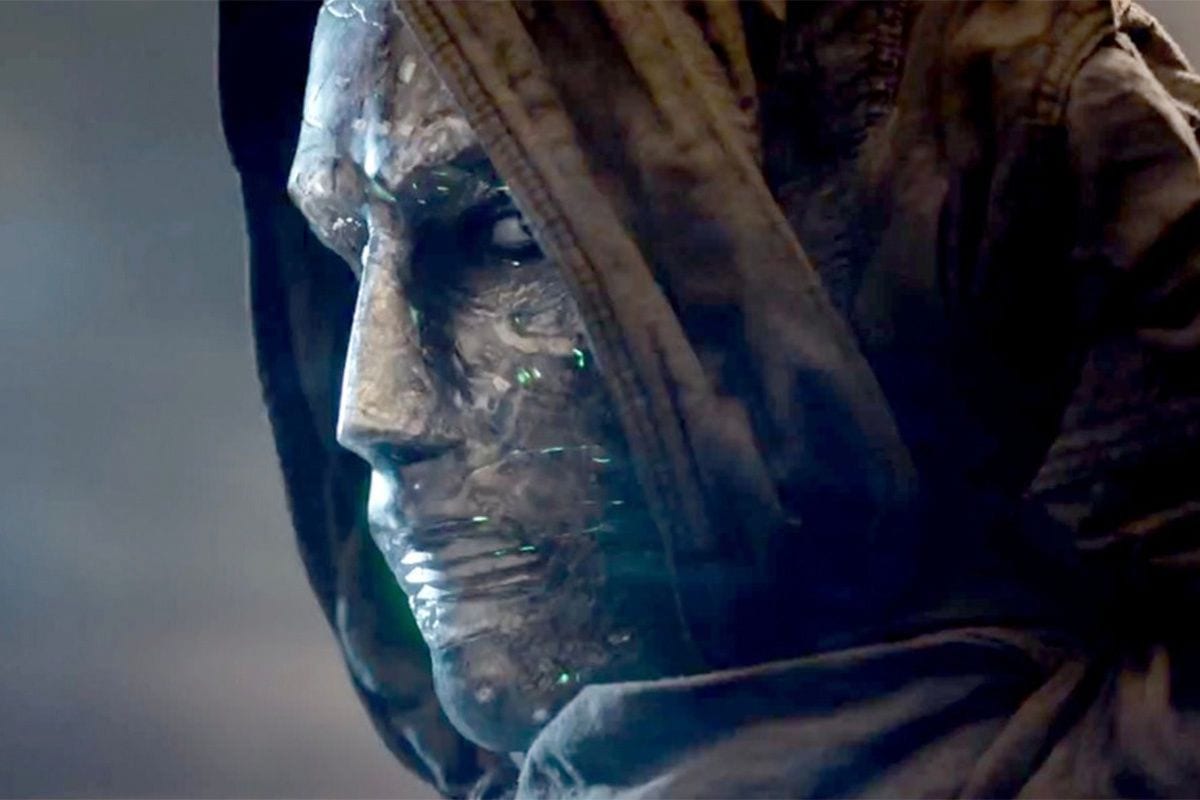
Toby Kebbell as Victor Von Doom / Dr. Doom (IMDB)
From then on, Reed and Ben are best friends, and theirs is the central relationship of the film. The eventual mishandling of that relationship sinks the film.
Seven years later, Reed (Miles Teller) and Ben (Jamie Bell) present their updated teleporter, now able to bring objects back, at the school science fair. Once again, they’re criticized by disbelieving teachers. However, Reed is approached by Professor Franklin Storm (Reg E. Cathey) and his daughter, Sue (Kate Mara). Storm has also been attempting to develop a similar teleporter, revealed to teleport between dimensions, at the Baxter Foundation in Manhattan, but Reed’s work is more advanced. Reed is given an immediate scholarship, moving him away from Ben for a large section of the film.
This allows introductions to the rest of the cast. Storm runs the Baxter Foundation with the hope that young scientists will find solutions to the problems caused by older generations. A board oversees him, led by Harvey Allen (Tim Blake Nelson), and they demand practical, marketable applications for the science. Storm holds them back as Reed and Sue develop Reed’s teleporter on a larger scale. Storm also brings in Victor von Doom (Toby Kebbell), a former Baxter Foundation student who developed their previous teleporter and left the project under poor circumstances. Finally, Storm coerces his son, Johnny (Michael B. Jordan), to help with the build to keep him out of trouble. With the team assembled, the building begins.
This is the most promising section of the film. There’s an inherent thrill to watching smart people work out problems, bond, and build something. The sets are cold with muted colours, and Trank shoots for a realistic look. I found myself enjoying the film quite a bit during these scenes, excited by the possibilities. The character development is disappointingly minor, though. Everyone takes the opportunity to remind Reed, and the audience, that his garage experiments were reckless. Victor hints at having an attraction for Sue, downplays Reed’s accomplishments, and is anti-authority, but all of those characteristics are underdeveloped.
The Storm siblings are the most one-dimensional. Sue is smart and has excellent pattern recognition, which is not a personality. And Johnny can build things, I guess. The cast, at least, is terrific, and their charisma, combined with the intellectual excitement of building the teleporter, make the section palatable.
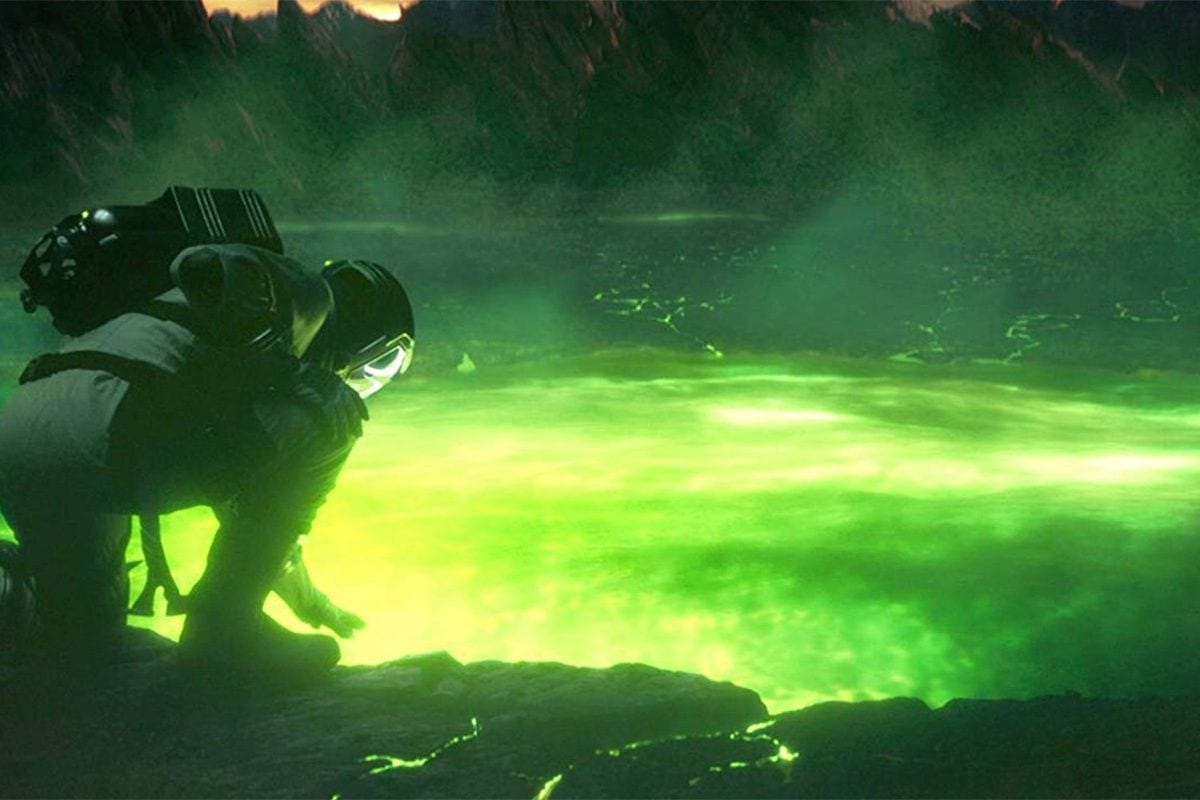
(Amazon)
When the teleporter is complete, the team successfully sends an ape through to the planet on the other side, and receives their first images of the lifeless, primordial terrain. Thrilled, the team prepares to be the first humans to travel interdimensionally, but Allen insists on sending trained astronauts. That night, Reed, Victor and Johnny drink away their troubles, and Reed drunkenly suggests that they use the teleporter without permission. He is reckless, remember? Reed calls Ben to join them. Ben’s inclusion feels a bit arbitrary, as does Sue’s exclusion, but Reed’s relationship to Ben needs to be re-established since it drives him in the second half of the film. The four men put on space-suits, enter the teleportation pods, and transport themselves to another dimension.
The other side is desert-like, with towering rock formations, stormy skies, and fissures with green, glowing energy. Victor and Reed insist on exploring further, but things go wrong when Victor touches some of the green energy. The fissures erupt, cliffs start to collapse, and everyone needs to rush back to the teleporter. Victor is taken by the green energy, but Reed, Johnny and Ben make it back to the pods. On Earth, Sue realizes what has happened and rushes to retrieve the pods. Ben’s door won’t close, and rocks fly towards him. Johnny’s window breaks, and he is engulfed in flames. The teleporter returns and explodes, hitting Sue with an energy blast that turns her invisible. Reed awakens in the wreckage and attempts to help. His legs are stuck under rubble, and he finds that he can stretch his body. He passes out, then awakens in a secret medical facility.
The filmmakers then explore the full, Cronenberg-esque body horror of their transformations. The sequence is scored with screechy, horror strings. Reed is strapped to a table, his arms stretched out several metres, barely able to move. Sue lies in a coma, fading in and out of visibility. Johnny is alive but on fire. Reed manages to pull himself together enough to follow Ben’s cries for help through the vents. He is horrified to discover Ben has become a rock creature. Reed promises that he will find a way to fix Ben, then he escapes the facility.
This sequence is the most impressively bold section of the film. Trank fully rejects any semblance of the light, fun, goofy aspects of the Fantastic Four to explore the terrifying ramifications of their powers. Certainly anyone looking for an old-fashioned Fantastic Four adventure would be turned off by this sequence. However, forgetting preconceived notions, the film works well enough on its own merits up to this point.
But then it hits a wall. The first hour is an imperfect but decent beginning to the story before the film can really let loose. But it never lets loose. Very little happens after this, shockingly little. Any excitement or potential gradually leaves the story like a slow leak in a tire, until the film ends and we are left staring at a flat tire. Until the climax, there are long stretches of conversation in which every character states exactly what they want and feel, and none of it is very interesting. There may have originally been some action in between these scenes, perhaps before Fox took over the film, but if so, I can’t imagine why Fox would cut them. It would be an act of self-sabotage to take a more interesting, exciting version of the film and cut it down to this slog.
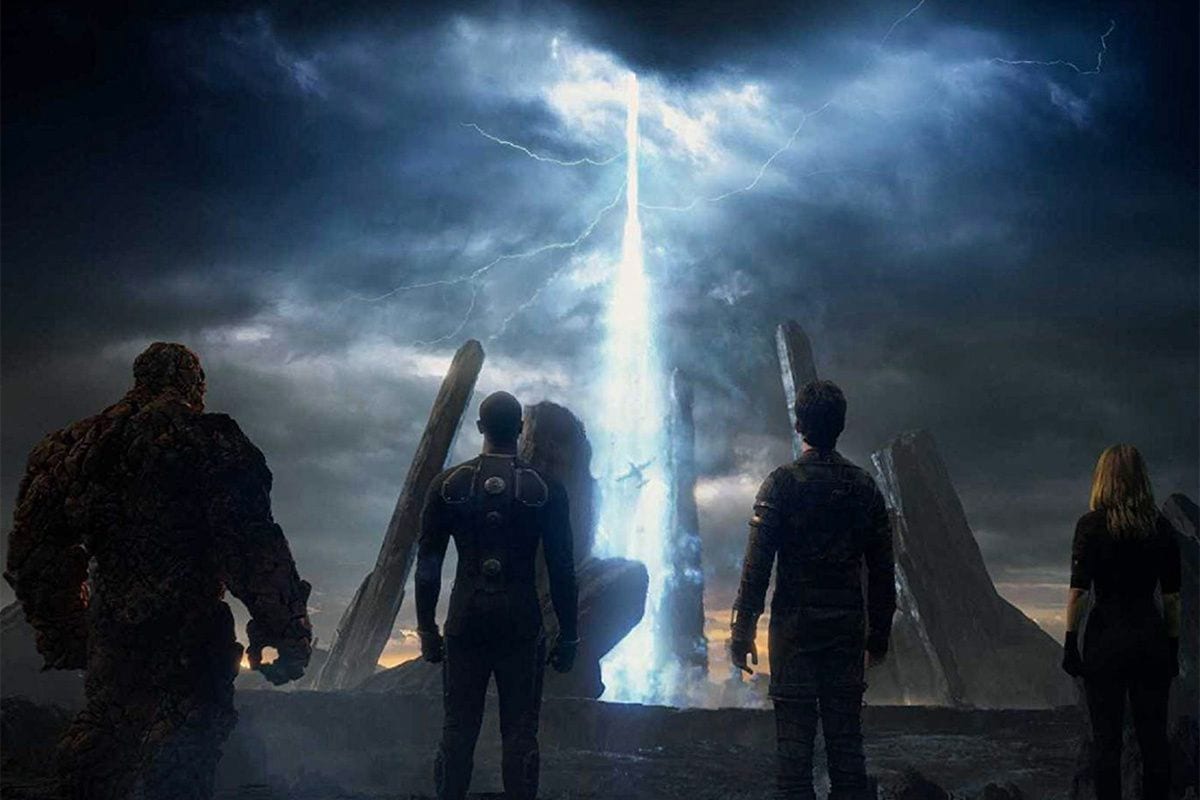
(Amazon)
After Reed escapes, there’s a one-year time jump. Allen has taken over the project and is rebuilding the teleporter to return to the other dimension. He tells the team that he wants to cure them, but he actually wants to harness the energy to make more super-powered individuals. He wants this because Ben, Johnny, and Sue have managed to gain control of their powers, and they are being trained as special operatives for the United States government. Johnny is thrilled with his powers, and he’s excited to use them. Sue, on the other hand, wants to be cured. We know all this because the characters say it, several times to several other characters. Besides the boredom of characters with fantastical powers relegated to chatting in non-descript rooms, this section expects viewers to care about Johnny and Sue, two of the more underdeveloped characters of the first half of the film. Absent any interesting plot developments, imagery or action, viewers are left to dwell on their dullness.
Ben, meanwhile, has been an active operative for a while. People say this and there are brief images of his missions on screens, but the giant, CGI rock monster mostly just broods in his room. What a waste. Reed and Ben’s relationship is central to the film, and it drives their actions for the second half. They bonded as children, Ben supported Reed, and Reed reciprocated by inviting Ben to the first interdimensional trip. Reed is now driven by guilt over Ben’s transformation, whereas Ben feels like Reed abandoned him when he escaped. There’s great dramatic potential there, but it’s only hinted at when the characters are apart. Reed is out in the world, attempting to build a new teleporter so that he can fix the accident. Sue tracks him online and then Ben captures him in an almost-action scene. Reed returns to fix the teleporter, which he does easily and without conflict. Ho, hum.
A team is sent through the teleporter and discover the planet no longer has any green, glowing energy. They also find Victor, hooded, fused into his suit, kept alive by the planet. They bring him back to Earth, and he immediately attacks the base with his new telekinetic and head-exploding powers. Allen and Storm are killed, and Victor somehow causes the teleporter to open a portal between the dimensions. This is visualized as a giant pillar of energy shooting into the sky, an overused image from dozens of blockbusters of this era that make the climax extra generic. Reed and Ben immediately reconcile, with minimal drama, to fight Victor. This resolves the central relationship of the film in the most unsatisfying way imaginable.
The ensuing action is also the lowest energy blockbuster climax I have seen in a while. Reports of the reshoots all agreed that the ending was completely redone, meaning this sequence was solely the vision of the Fox executives. The main problem is that the film, up to this point, is slow-moving, somewhat thoughtful, and grounded. A big exciting climax would not have been consistent with what came before, so maybe the action is toned down and sleepy to compensate. Or, maybe it’s just poorly done.
Each of the characters attack Victor on their own and are defeated easily. So, of course, they realize that they must work together. Reed gives them a pep talk, and they spring into action. Victor’s plan or threat is never fully established, and they beat him pretty easily once they unite. None of it seems to matter, and who cares? Once the team returns, they all immediately accept their powers, get over their grudges, and vow to work together. All the brooding after the accident is somehow rendered more meaningless in order to have a happy ending with the newly formed team. Just as Reed is about to say the team name, the credits begin. I guess it is appropriate to cut the name “Fantastic Four” out of a film that handles the property so terribly.
Why was one of the most significant, longest-running comic book series in history so hard to adapt into a film? Why does Fox insist on hiring filmmakers with strong track records or clear visions, then meddle with their films after the fact? I don’t know the answer to these questions. I do know that Josh Trank’s Fantastic Four somehow managed to make the previous, Tim Story-directed films look good by comparison. The film starts out well, building potential with an interesting tone, a great cast, and exciting science, and then the second half just… deflates.
The fallout from the film was disastrous and far-reaching. Fantastic Four was nominated for five Golden Raspberry Awards, and “won” three, including Worst Picture. It grossed $167 million worldwide on a production budget of $120 million. It was the lowest grossing Marvel Film since Ghost Rider: Spirit of Vengeance (Neveldine/Taylor, 2012), and that film had half the budget. A sequel was scheduled for the summer of 2017, then quietly removed from Fox’s schedule in late-2015. The failure even affected other films. As a direct result of Fantastic Four, Fox slashed the budget of a Gambit film starring Channing Tatum 12 weeks before shooting. The filmmakers were unable to make the film work on a reduced budget, and the entire project was scrapped. Finally, just as a coincidence, the Marvel Comics event Secret Wars officially ended the Ultimate Marvel Universe in 2015.
And so, 2015 ended up being the year of director conflicts on Marvel Films. Around the release of Avengers: Age of Ultron (Whedon, 2015), Joss Whedon was very public about his conflicts with Marvel and dissatisfaction with aspects of the film. He later regretted those comments, but they had an effect. Edgar Wright worked for nearly a decade on Ant-Man (Reed, 2015) only to leave the project over creative differences just before filming. And then there was Josh Trank, who was shut out of his own film and made his feelings about that known. As previously-mentioned, Trank’s Star Wars project was cancelled, and he didn’t direct another film until Fonzo (Trank, 2019). In 2018, Trank removed Fantastic Four from his filmography on Instagram, wanting to distance himself from it as much as possible. It’s difficult to say whether these directorial conflicts were happening more frequently, or if the public was simply made more aware of them due to social media.
As for the Fantastic Four, the cinematic future of the property remains uncertain. In December 2017, The Walt Disney Company, which owns Marvel Studios, agreed to acquire 21st Century Fox. The acquisition took effect in March 2019. Among the numerous ramifications of this merger was that Marvel Studios acquired the film rights to all Fox-owned Marvel properties, including the X-Men and the Fantastic Four. Given the importance of both properties to the history of Marvel Comics, it’s incredibly likely that Marvel Studios will introduce them to the MCU at some point. As of this writing, however, no details have emerged regarding the Fantastic Four.
I have an idea of how to adapt the characters to film: They worked best in the ’60s, so set the films in the ’60s. A period Fantastic Four film, set in the time period the characters were created, would allow it to be bright, colourful, cheesy, and faithful in all the right ways. Then, after a couple of ’60s-set films, the team could be caught in a pocket dimension and resurface in the present. This will never happen, the MCU already has enough time-tossed heroes like Captain America and Captain Marvel, but that’s my pitch. For now, I have faith that Marvel Studios will do the comic justice and maybe the Fantastic Four will finally get a film worthy of their name.
Stan Lee Cameo Corner
Lee does not appear in the film, which is very telling. That is 24 cameos in 38 films.
Credits Scene(s)
No credits scenes setting up other films or sequels which, again, is very telling
First Appearances
Michael B. Jordan would go on to appear in the vastly superior Black Panther (Coogler, 2018). After Chris Evans, Jordan is the second cinematic Johnny Storm to go on to a critically acclaimed role in the MCU.
Next Time
Ryan Reynolds finally gets his chance to make a vulgar, R-rated Deadpool film, and the world is better as a result.

![Call for Papers: All Things Reconsidered [MUSIC] May-August 2024](https://www.popmatters.com/wp-content/uploads/2024/04/all-things-reconsidered-call-music-may-2024-720x380.jpg)



